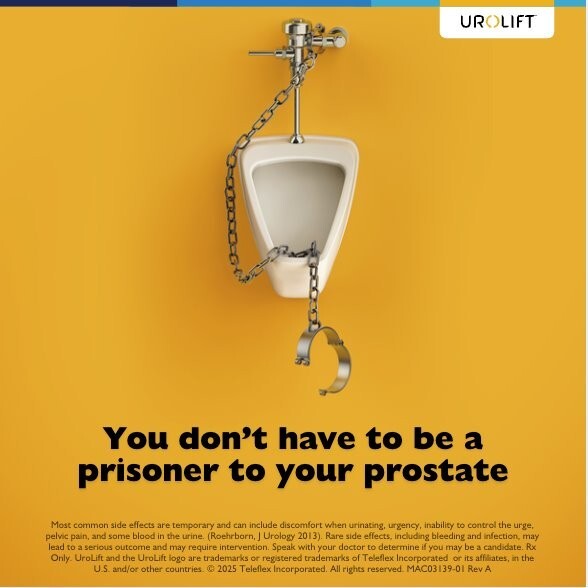
It’s pee o’ clock, again
If you’re waking up throughout the night, it may be more than just getting older.
An enlarged prostate could be the culprit. The UroLift™ System can provide lasting relief.1 Learn why over half a million men have chosen the UroLift™ System.2
Meet the #1 chosen minimally invasive BPH procedure in the U.S.§
Living with BPH symptoms? The UroLift™ System is a proven option for men seeking an alternative to medications or major surgery.1
Click below to find a UroLift™-trained physician near you.

Get back on track with the UroLift™ System
The goal of the UroLift™ System treatment is to relieve symptoms quickly and effectively so you can get back on track and resume your daily activities.
This straightforward outpatient treatment can be performed under local anesthesia.2 It’s the only leading BPH procedure that does not require cutting, heating or removal of prostate tissue.3,4
- Rapid relief and recovery in days, not months2,3
- Only leading BPH procedure shown to not cause sexual dysfunction**4,5
- Symptom relief better than reported for medications3,6
- Covered by Medicare, national, and commercial plans, when medical criteria are met
Of men in their 50's have BPH
Of men in their 60s have BPH
Meet Mike. He's fifty seven years old and lives an active lifestyle. Between playing golf with his buddies and spending time with his wife, life is good. Although, in the past year, Mike started noticing problems with his urination, like having to wake up several times a night to go, having to find a men's room all the time when he's out, and having trouble actually starting to urinate as if something was blocking the flow. These symptoms could mean that Mike has an enlarged prostate, a condition called benign prostatic hyperplasia, or BPH. A man's prostate grows over time and can compress the urethra, blocking the passageway and preventing normal urine flow. This progressive condition is very common among men as they age. In fact, over forty percent of men in their 50s have BPH, and the number grows to over seventy percent of men in their 60s. Rest assured, BPH has nothing to do with prostate cancer, but it can greatly affect a man's quality of life. As the prostate grows, bothersome symptoms can occur, including a frequent need to urinate without completely emptying the bladder, a poor stream during urination, starting and stopping, embarrassing leakage and dripping, and even painful urination. Men suffering from BPH often make multiple trips to the bathroom during the night, affecting their sleep and relationships. For too long, men suffering with BPH have had to choose between only three options: watchful waiting, medications, or surgeries that cut laser or steam to destroy prostate tissue. For the first option, patients just live with the symptoms. It's called watchful waiting, which simply means to modify behavior and lifestyle as symptoms of BPH worsen. It can include drinking less before bedtime and always making sure there's a bathroom nearby. Some downsides besides the physical discomfort are that symptoms typically get worse over time, and waiting now may make it harder to reduce symptoms later. The second option is taking prescription medications with the potential for many common side effects. Unfortunately, drugs don't work for everyone, with two out of three patients surveyed expressing frustration over their BPH medication. Drugs can take several months to work and require continual use to manage symptoms while becoming less effective over time. Side effects may include headaches, dizziness, weakness, nasal congestion, loss of libido, ejaculatory dysfunction, erectile dysfunction. No wonder nearly twenty five percent of men on prescription BPH medications in the US discontinue their drug use each year. The third option is surgery to destroy or remove part of the prostate, which comes with its own set of side effects. Surgery is generally recognized as an effective treatment for BPH. Unfortunately, until now, surgery meant more complications, including the clinically demonstrated potential for erectile and ejaculatory dysfunction and a long recovery time, frequently including use of a catheter. And some less invasive surgical procedures even require retreatment as much as twenty five percent of the time. No wonder millions of men give up and choose to live with their BPH. Now, there's a proven solution that fills the gap between prescription medication and more invasive surgical procedures. Mike's doctor told him about the UroLift System treatment FDA cleared in twenty thirteen. The system treatment is typically performed as a one time outpatient solution that provides rapid relief with a fast recovery. The system uses tiny implants to hold open the obstructed pathway so it no longer blocks urine flow. There's a new procedure that's recently been approved in the United States, and that's UroLift. This has been a great experience for me, and I would recommend UroLift for men. I notice results actually the same day. And over the next year, it just has continued to get better. It was excellent. The UroLift procedure provides a truly minimally invasive treatment that can be performed in the physician's office. Most patients no longer need to continue BPH medications, and they can avoid the slower recovery of tissue destructive prostate surgery. Clinical studies have shown that the UroLift system is the only leading BPH treatment option that does not cause ejaculatory or erectile dysfunction. Best of all, five years of clinical data on hundreds of patients show consistent results and durable relief from the symptoms of BPH. Now with the system procedure, Mike has discovered a better option that can very likely free him from his BPH medication without the discomforts of more invasive surgery so he can quickly get back to what matters most. Ask your doctor if you are a candidate for UroLift.
Mike visits his doctor to talk about enlarged prostate treatment options
The system treatment was the right option for Mike. His doctor shared that the system is not a traditional surgical treatment and is typically done in an outpatient setting. This treatment does not destroy or remove prostate tissue as it holds open the obstructed pathway that is blocking urine flow, and it's able to provide significant improvements without the significant downsides often associated with traditional surgery. The system enables most men to get off their BPH medications and avoid the long list of side effects from pills as well. It's the BPH relief you've been looking for. After your initial system consultation with your doctor, here's what to expect next. First, your doctor will typically perform what is called a cystoscopy. A tiny, flexible camera will be used to examine your prostate and bladder to determine if you will be a good candidate for the system. If you are like the vast majority of men who suffer from BPH, the system could be a recommended treatment solution for you. If the system is right for you, your doctor will share how to prepare for your procedure, including potential temporary discontinuation of certain medications. If your doctor schedules you for an outpatient procedure, you should plan on about one to two hours from the time you walk into your treatment location to the time you walk out. Often, the system treatment is performed right in your doctor's office or in an outpatient surgical center under local anesthesia. The system treatment may also be done in a hospital setting under general anesthesia, which may require a little extra time before you're able to walk out. Your doctor will help you decide on the best facility for your treatment. Your doctor will also recommend the appropriate post procedure care for you. In a majority of cases, patients will not require a catheter following treatment. In some instances, your doctor may recommend a catheter for a short period and you may experience light blood in the urine. And typically, within a few days, you'll be able to experience lasting relief from your BPH symptoms and rapidly get back to your normal activities. Also, the UroLift System treatment has no instances of new sustained sexual dysfunction, so you can quickly continue with the life you love.
Mike chose the UroLift System procedure and learns what to expect
Do I have BPH?
If you have been living with any of these bothersome symptoms, you might have an enlarged prostate. Select all that apply.
You selected 0 out of 3. Did you know, BPH is the leading reason men visit a urologist?7
Take the BPH symptom screener now to get your score, along with a printable report.
So far it's just annoying – why worry about BPH?
Waiting can come with risk.
BPH is a common condition affecting men as they get older. It is not related to prostate cancer, but is the leading reason men visit a urologist.7
As the prostate enlarges it can press on and even block the urethra, causing bothersome urinary symptoms. If left untreated, BPH can lead to permanent bladder damage.8
What are my options?
Your doctor can advise you on potential treatment options for your lower urinary tract symptoms (LUTS), based on your diagnosis. Here are common treatment options for BPH:
Medications
These include alpha blockers, which relax bladder neck muscles, and 5-alpha reductase inhibitors which act to shrink the prostate.
UroLift™ System
Small implants are placed to lift or hold excess tissue out of the way so it no longer blocks the urethra – with no heating, cutting, or removal, of prostate tissue.3,4
Thermotherapies
Heat, such as steam or hot water, is applied directly to the prostate to destroy excess tissue.
Laser
Concentrated light is used to generate precise, intense heat to destroy excess prostate tissue.
Waterjet Ablation
A high-velocity waterjet is used to destroy excess prostate tissue, using an image-guided robotic arm.
Transurethral Resection (TURP)
An electric wire loop or laser fiber is used to remove or vaporize excess prostate tissue.
What are people saying?
Scroll through these quotes from patients treated with the UroLift™ System. See Success Stories to view videos and articles featuring BPH patients, family members, and their urologists.

Frequently Asked Question
Do UroLift™ implants interfere with an MRI?
See the printable MRI Information Card for UroLift™ System patients. Visit our FAQs page for more detail and other helpful information.
View the CardInsurance Info
The UroLift™ procedure is covered by Medicare, national, and commercial plans.* Learn more.
*when medical criteria are met
Read the BPH Blog
Check out these helpful articles on BPH and related topics.
References
1. Roehrborn, Can J Urol 2017
2. Shore, Can J Urol 2014
3. Roehrborn, J Urology 2013
4. AUA BPH Guidelines 2003, 2020
5. McVary, Urology 2019
6. AUA BPH Guidelines 2003
7. IMS Health NDTI Urology Specialty Profile, July 2012 - June 2013
8. Tubaro, Drugs Aging 2003
§ U.S. 2022 estimates based on US Market Model 2022-24 (5-17-22 FINAL), which is in part based on Symphony Health PatientSource® 2018-21, as is and with no representations/ warranties, including accuracy or completeness.
**No instances of new, sustained erectile or ejaculatory dysfunction in the L.I.F.T. pivotal study
†As with any medical procedure, individual results may vary. See patient safety for more information.
MAC11000-02 Rev A

